Abstract
Potential depletion of fossil fuel and climate change have globally accelerated the demand in renewable and alternative energy. Most of the Southeast Asian countries have an abundance of biomass sources for the energy sector due to their agriculture-based economy and enormous forest resources. Therefore, the study aimed at highlighting an overview of biomass energy in the Southeast Asia countries to convey the environmental and economic benefits from the available biomass sources in the region. In order to achieve the aim, the study synthesized and evaluated the biomass sources, energy potential, utilization, and management in the region, based on the published research papers, review papers, and country reports. It was found that the major biomass sources in this region were fuelwood, wood residues, rice husk, rice straw, sugarcane residues, oil palm residues, and coconut residues. The total annual quantity of the biomass potential from agriculture and forest sector in the region was estimated at more than 500 million tons per year and equal to over 8000 million gigajoules of total energy potential. In order to implement the sustainable utilization of biomass sources, the study specified the barriers and challenges of biomass utilization in these countries and proposed a sustainable approach of biomass energy, by comparing the way of traditional biomass utilization.
1. Introduction
Booming economies have greatly accelerated energy consumption in the Southeast Asian countries. The energy consumption is projected to grow 2.6 times during 2005–2030 [1] and the energy demand will probably rise by almost two-thirds in 2040, representing one-tenth of the rise in global demand [2]. Meanwhile, the energy-related environmental pollutions caused vastly by greenhouse gas emissions from the energy sector will rise regionally and globally, as well. Due to the impact of climate change, the Southeast Asian countries, especially Indonesia, Philippines, Thailand, and Vietnam, need to begin rapidly investing in renewable forms of electricity supply [3,4].
Biomass energy is by far the largest renewable energy sources, representing 10.4% of the world’s total primary energy supply or 77.4% of global renewable energy supply [5]. Asia is a key supplier of biomass feedstock to markets such as Europe or the United States but within the region, new opportunities and investments in biomass are emerging, particularly in Southeast Asia [6]. Southeast Asia, with its abundant bioenergy resources, holds a strategic position in the global biomass energy atlas [7]. It is also a big producer of agricultural and wood products, and according to conservative estimates, the amount of biomass residues generated from sugar, rice, and palm oil mills is more than 200–230 million tons per year, which corresponds to cogeneration potential of 16–19 gigawatts (GW) [7].
Nowadays, Southeast Asia is fast becoming an attractive market for developing biomass as an energy source [6] and biomass energy could provide 26% of total primary energy supply, equal to 87% of the renewable energy supply [5]. Many Southeast Asian countries are among the top producers of agricultural commodities such as rice, sugar, cane, palm oil, coconut, and rubber, and the most promising residues are rice husk, sugarcane bagasse, oil palm residue, and wood residues [5].
The average annual energy consumption in the Southeast Asian countries is estimated at approximately 3.9% and the average carbon emission has been increased by over 5% due to the fast economic growth in the region [8]. Bakhtyar et al. [8] state that increasing purchasing power parity leads to an increase in per capita electricity consumption, hence increasing per capita carbon dioxide (CO2) emission. Figure 1 shows a relationship between per capita electricity consumption, purchasing power parity, and CO2 emission. Although carbon dioxide is the largest source of global greenhouse gas emissions that come greatly from energy sector, it is not the case for some of the Southeast Asian countries, where forestry and agriculture are the major sources of emissions [9].
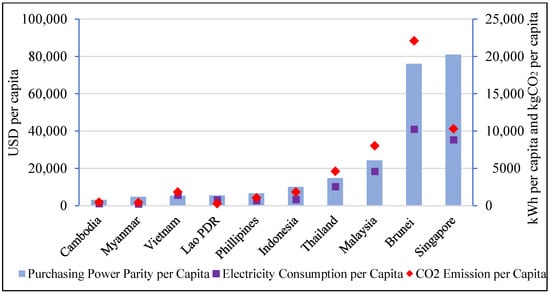
Figure 1.
A relationship between per capita electricity consumption, purchasing power parity, and per capita CO2 emission in Southeast Asia (2014) [10,11,12,13].
Some of the Southeast Asian countries such as Singapore, Brunei Darussalam, Malaysia, and Thailand have already accessed 100% of electricity (Figure 2). Meanwhile, other countries are expected to reach 100% access to electricity by 2030.
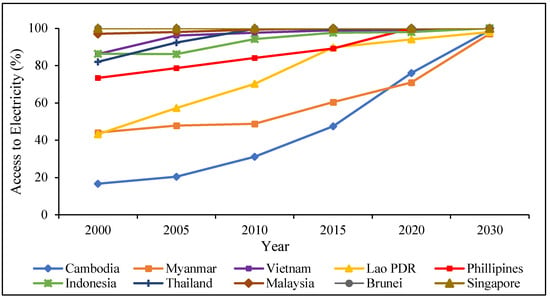
Figure 2.
Access to electricity in the Southeast Asian countries [2,14].
Figure 3 shows the share of renewable energy to the total electricity generation. The total electricity generation from the renewable and non-renewable generation amounted to approximately 856 Terawatt-hours (TWh). Out of this, 20% came from renewable energy, accounting approximately for hydropower (74.1%), biofuels (12.6%), geothermal (11.5%), solar phtovoltaic (PV) (1.2%), and wind (0.6%).
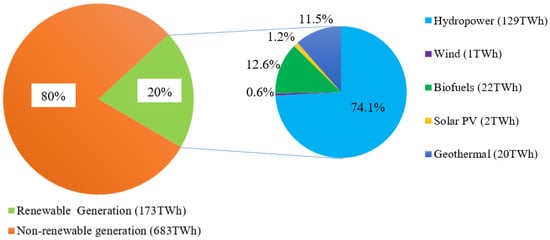
Figure 3.
Share of renewable energy to total electricity generation in Southeast Asian countries (2014) [9].
The potential share of renewable energy in total primary energy supply in the Southeast Asian countries is presented in Figure 4. On a country level, the renewable energy share in total primary energy supply seems to increase significantly, especially in the countries that completely phase out traditional uses of bioenergy, such as Cambodia, Lao PDR, Indonesia, and Myanmar [9]. In Lao PDR, the potential share of biomass energy in total primary energy supply is likely to reach over 50% of the total primary energy supply by 2025.
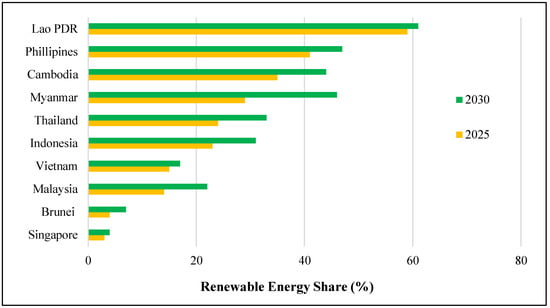
Figure 4.
Potential share of renewable energy in total primary energy supply in the Southeast Asian countries. Source: [9]; https://www.irena.org/publications/2017/Mar/Renewable-Energy-Prospects-Indonesia.
Several studies have focused on the renewable energy, biomass energy, renewable energy sources, energy utilization, policy, and emission factors in Asia [2,8,9,15,16,17,18,19] but mostly in specific countries such as Indonesia, Malaysia, Cambodia, Lao PDR, Brunei Darussalam, Philippines, etc. [20,21,22,23,24]. Therefore, the study highlighted the biomass sources, energy potential, and management in Southeast Asian countries to ensure the biomass sources and their energy utilization be applicable to the policy makers, researchers, and non-government organizations for outlooking biomass energy as an important portion of the future renewable energy sector in the region.
2. Methodology
Since most Southeast Asian countries are developing countries, the country-specific data related to biomass sources, energy potential, and utilization in some countries including Myanmar, Cambodia, and Lao PDR have not been sufficiently accessible during recent years. Therefore, the data were collated to a feasible extent from the peer-reviewed research papers, reviewed papers, policy reports by the organizations such as Asian Development Bank, the World Bank, United Nations Food and Agriculture Organization, International Energy Agency, International Renewable Energy Agency, and reports by non-government organizations. Then, the study synthesized and evaluated the biomass sources, energy potential, utilization, and management in the Southeast Asian countries to highlight the potential utilization of the available biomass sources in the region. Additionally, the barriers and challenges of biomass utilization in these countries were also described. Finally, the study proposed a sustainable approach of biomass energy by comparing the way of traditional biomass utilization.
3. Results and Discussion
Biomass Sources and Utilization in the Southeast Asian Countries
The region is situated in a tropical zone and has the capacity to produce the large quantities of biomass all the year round, out of which woody biomass from forests constitutes a particularly valuable source of energy in the form of domestic fuel for local residents [16]. Additionally, the majority of the countries have an abundance of agriculture residues for biomass energy sources, due to their agriculture-based economy. For instance, with 45% of forest cover and agriculture-based economy, Myanmar has gained the biomass resources from the forest sector and agricultural sector. Therefore, the major biomass sources in the country include wood residues, rice husk and rice stalks, sugarcane residues, oil palm residues and other agricultural resides (Figure 5). The forest and agriculture resources for biomass sources in the Southeast Asian countries are presented in Table 1.
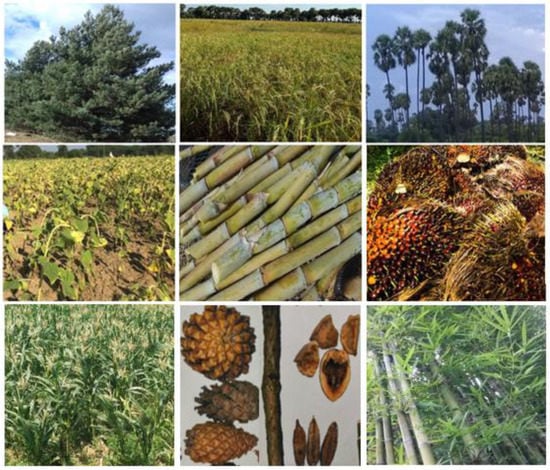
Figure 5.
Biomass resources in Southeast Asia, based on Myanmar. Photo credit: Aung Myat Thu; Lwan Wai, Myanmar Survey Stars; Myint Naing; Theint Theint Win, Toe Toe.

Table 1.
Forest and agriculture resources for biomass sources in the Southeast Asian countries [15,16,20,21,25,26,27].
Table 2 presents biomass sources and their energy potential in the Southeast Asian countries while Table 3 describes the utilization of biomass energy in the region. It is found that the total quantity of the residues from the agriculture and forest sector is estimated at over 500 million tons per year. Additionally, the total biomass energy potential in the countries has over 8000 million gigajoules. Based on Table 2 and Table 3, biomass sources and biomass energy utilization in each of the Southeast Asian countries are briefly described as follows:

Table 2.
Biomass sources and their energy potential [15,20,21,22,23,26,27,32,33,43,44,45].

Table 3.
A comparison between theoretical biomass energy potential and installed capacity with project targets [6,8,24,27,29,31,33,36,39,46,47,48,49].
(a) Cambodia
Cambodia has 10,094,000 hectares of forest area, having 57% of the total area of the country. Therefore, wood and wood charcoal account for approximately 80% of the total energy consumption in Cambodia. Approximately 80% in urban and 94% in rural areas are used for cooking [26]. The other major biomass sources come from agricultural residues including rice husk, rice straw, corn cob, cassava stalk, bagasse, groundnut shell and husk, and coconut shell and front. Currently, the total installed capacity from biomass is about 23 MW. Cambodia is planning to produce 73 MW of installed capacity from biomass by 2030.
(b) Myanmar
Myanmar is an agriculture country, covering 45% of the area with forest. Myanmar produces over 20 million tons of paddy annually. Therefore, the major biomass sources of the country are obtained largely from the forest and agriculture sector. Since 70% of the population resides in rural areas, they are mostly dependant on solid biomass fuels. Approximately 65% of the total energy consumption of the country comes from biomass sources [28]. The total capacity potential from biomass and biogas is estimated at 6899 MW and 4741 MW, respectively [29]. Out of this, the total installed capacity has reached 115 MW.
(c) Lao PDR
With 68% of the forest cover, Lao PDR has an abundance of biomass resources from the forest sector. Since the majority of the population live in the rural areas, 80% of the households rely on fire wood and charcoal, having 68% of its primary energy supplies [26,30]. In addition to the forest sector, the agriculture could provide a wealth of biomass resources due to its agriculture economy. The installed capacity of biomass energy is about 40 MW and is being planned to achieve 58 MW by 2025.
(d) Vietnam
Being an agricultural country, Vietnam has an abundance of biomass energy sources, with over 300 GW of theoretical capacity potential [31]. Biomass is mainly used in households (76%), and the rest (24%) is used in small industrial boilers and combined heat and power (CHP) plants in sugar mills [32]. The major biomass sources include forest residues, rice husk, rice straw, bagasse, cane trash, maize trash, cassava stem, peanut shell, coffee husk, and coconut shell. The main energy consumption potential in Vietnam is aimed at municipal and industrial co-generation power plants [32]. Vietnam has set a target of having a combined capacity of 500 MW of biomass power by 2020, which is raised to 2000 MW in 2030 [33].
(e) Philippines
As the energy needs of the Philippines rely predominantly on the imports of fossil fuels, the government have looked at renewable energy for possible alternatives [34]. Among the alternatives, biomass energy is crucial to the country and nearly 30% of the energy for the 100 million people living in the Philippines come from biomass and are mainly used for household cooking by the rural population [27,35]. Additionally, biomass industry is rapidly advancing, with 276.7 MW of a total installed capacity around the country [36]. Biomass energy application accounts for around 15% of the primary energy use in the Philippines [35].
(f) Indonesia
Among the Southeast Asian countries, Indonesia has an abundant growing stock in forests due to its most extensive forest area, having 94,432,000 hectares [16]. Besides, in Indonesia economies, important biomass fuels are derived from agriculture residues and used in both traditional and modern applications [21]. The major agriculture biomass sources are oil palm residues, sugarcane residues, rice husk and rice straw, and corn cob. It is estimated that Indonesia produces 146.7 million tons of biomass per year, equivalent to about 470 million gigajoules (GJ) per year [37]. The total estimated capacity potential from biomass accounts for approximately 50,000 MW, with 312 MW of installed capacity.
(g) Thailand
Thailand is an agricultural country, with a huge biomass energy potential for fulfilling additional energy requirements of the country. Biomass sources could cover up to 15% of the energy demand of the country [38]. The capacity potential from utilization of biomass and biogas is estimated at 7000 MW and 190 MW, respectively [8,39]. Most of the biomass-fired industrial facilities are large-scale, centralized plants operating at economies of scale [40]. The installed capacity from biomass and biogas accounts for 1610 MW and 46 MW, respectively, with 3.630 GW of installed capacity for a project target by 2021 [8,39]. Thailand’s board of investment (BOI) promotes the production of electricity or steam from renewable energy, such as biomass by an eight-year tax holiday, exemption of import duty on machinery, raw, or essential materials used in manufacturing export products [40].
(h) Malaysia
Malaysia has a huge forest area, with around 62% of the total land area. Agriculture also covers approximately 4,890,000 hectares of the whole country. Therefore, Malaysia has the numerous biomass resources such as oil palm residues, sugarcane residues, and coconut resides. The palm oil industry alone contributes to about 8% or over RM 80 billion to the country’s gross national income (GNI), making it by far the largest contributor within the agricultural sector, naturally generating the largest amount of biomass [6]. Industry figures put this amount at 83 million dry tons in 2012 and this is likely to increase to 100 million dry tons by 2020 [6]. The total installed capacity potential from biomass is estimated at 29,000 MW, with 211 MW of the installed capacity [8].
(i) Brunei Darussalam
With plentiful oil and gas resources, Brunei Darussalam relies majorly on fossil fuel not only for its national energy security and booming economy [23,41]. For this reason, it had minimal interest in the use of renewable energies, but due to mounting worldwide interest in this and in order to diversify its energy sources and bolster its energy security, it set out a goal of adopting 10% electricity from renewable energies in 2035 [41]. Biomass sources in the country account for coconut shell, coconut fiber, corn fiber, rice husk, and saw dust, with approximately 8.773 kilo GJ of the annual biomass energy potential.
(j) Singapore
Being composed of 63 islands, Singapore has a total area of 722.5 square kilometers and approximately two hectares of forest area. In 2007, Singapore identified clean technology as a key driver of economic growth, allocating S$700 million to fund research and development (R&D), innovation, and manpower development in the sector [6]. Singapore has gained a reputation as a clean, green “garden city” [42]. Utilization of horticultural and wood wastes processed by ecoWise could produce approximately 0.9 MW of electricity and 5.4 MW of heat for co-generation plant [6]. The total biomass energy potential from biomass accounts for approximately 2.901 million GJ [43] and the installed capacity from biomass sources accounts for 220 MW [8].
Nowadays, there already exists several applicable technologies for biomass energy utilization in the Southeast Asian region. These technologies include direct combustion and cofiring of biomass products for heat and electricity, anaerobic digestion of animal wastes for methane-rich gas, pyrolysis of biomass products for bio-char, gas, and oil, gasification of agricultural waste such as rice husk and others, wood chips, sawdust, forest residues, product waste, etc. In Thailand, the combustion of agriculture residues for power generation can be widely seen around the country. Meanwhile, in Myanmar, power generation from biomass gasification has been conducted by the government institutions and private sectors. Upon the different fuel alternatives and local supply demand, various ranges of generating capacities for the gasification plant can be found; especially rice husk biomass gasification shares the most due to that the staple food is rice in Myanmar agricultural system. Additionally, small villages within 100–200 households could be provided electricity for lighting with 10 kW power generation capacity via 25 hp gas engine, which was operated by biogas produced from 50 m3 fixed-dome type biogas plant using the cow dung waste from the household. A comparison between theoretical biomass energy potential and installed capacity with project targets in the Southeast Asian countries is presented in Table 3. By far, the total installed capacity in the Southeast Asian countries accounts for approximately 3 GW from biomass and around 330 megawatts (MW) from biogas. It was observed that the applied technologies for the installed capacity of biomass energy included gasification, co-firing, and direction combustion while the installed capacity of biogas power plants was majorly gained from anaerobic digestion.
As a major source of biomass fuels, fuelwood plays a key role for cooking and heating in the rural areas of most Southeast Asian countries. However, due to deforestation and logging (including illegal logging), the projected annual woody biomass production in natural forests declined from 815.9 million tons (16.3 EJ) in 1990 to 359.3 million tons (7.2 EJ) in 2020 [50]. Hence, average annual woody biomass production in all forests in Southeast Asia between 1990 and 2020 was estimated at 563.4 million tons (11.3 EJ) per year declining about 1.5% per year [50]. In addition to deforestation, the development of renewable energy sector has largely affected the fuelwood consumption in the Southeast Asian region. Therefore, it could be seen that there is a decline in the projected annual consumption of fuelwood in Southeast Asia after 1990, trending from 222 million cubic meters in 1990 to 122 million cubic meters in 2020 (Figure 6a). Additionally, beyond 2020, it might potentially be seen that there could also be a substantial decline in annual fuelwood consumption in the Southeast Asian countries due to not only deforestation and logging [50] but also the strategic plans and implementations of the ASEAN (Association of Southeast Asian Nations) community related to the promotion of the renewable energy sector development (majorly in hydropower, biomass energy, geothermal energy, solar, and wind energy). In the ASEAN community, it is found that the share of the renewable energy has been set a target from 15% for the total ASEAN installed power capacity by 2015 to 23% for the total ASEAN energy mix by 2023 [18].
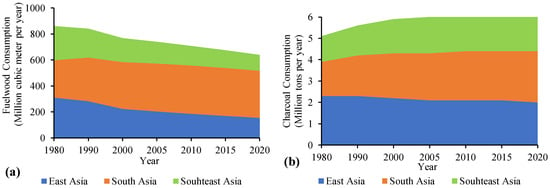
Figure 6.
Trends of (a) fuelwood consumption and (b) charcoal consumption in Asia Region [51].
However, the annual charcoal consumption in the Southeast Asian region seems to remain nearly stable from 2005 (Figure 6b). This situation could probably highlight that since some of the Southeast Asian countries, especially Myanmar, Lao PDR, and Cambodia, are trying to provide 100% access to the electricity nationwide by 2030 [2,14], the people in rural and urban areas are still relying on charcoal consumption for cooking and heating in case of the electrical power outage and electricity shortage, despite the reduction in avoidance of direct consumption of fuelwood.
Figure 7 shows the ratio of bioenergy demand and supply in selected Southeast Asian countries in 2025. Among the selected countries, the ratio of bioenergy demand and supply in Myanmar is likely to be the lowest, with 20% in low estimate and over 30% in high estimate, due to its major focus on hydropower and solar power utilization. On the other hand, Thailand seems to have the highest ratios in both low and high estimate in 2025, along with the quality improvement of biomass fuels, technology advancements, and market opportunities. Table 4 show the methods of biomass energy utilization in the Southeast Asian countries. Since most of the countries have a higher rural population, the traditional ways of biomass energy utilization such as traditional consumptions for cooking and heating, animal feeds, dumping, and open burning are significantly practiced. Due to the high capital cost of technologies, lack of skilled personnel, and uncertainty of economic benefits, most developing countries could not afford to apply the technologies related to refuse-derived fuel (RDF), pyrolysis, and liquefaction. For instance, the actual status for RDF application in Myanmar could be hardly seen. However, some demonstrated facilities for biomass briquettes, especially for rice husk, donated from the foreign countries could be seen in the country. Therefore, the technologies related to biomass energy have been well applied only by a few countries such as Singapore, Thailand, and Malaysia in the region.
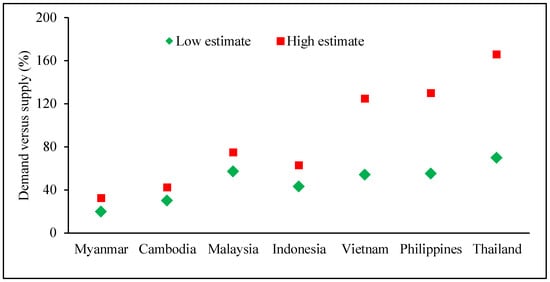
Figure 7.
Ratio of bioenergy demand and supply in Southeast Asia countries in 2025 [9].

Table 4.
Methods of biomass utilization in Southeast Asian countries [6,8,9,15,18,27,29,31,33,36,46,48,52].
4. Barriers and Challenges for Utilization of Biomass
Scaling up sustainable, modern forms of bioenergy will be crucial both to address the energy access challenge, and to increase renewable energy use in both industry and transport [9]. Table 5 presents the barriers and challenges for utilization of biomass. Policy and institutional aspects are crucial to development of biomass energy sector. However, specific goals and targets on the biomass energy development could not clearly seen in most of the countries yet. Meanwhile, as driven by the low economy growth of the countries, lack of sufficient funding for research and development and purchase of technologies is one of the biggest challenges in the development of biomass energy sector in most of the Southeast Asian countries such as Myanmar, Lao PDR, and Cambodia. Likewise, public and private sector involvement is still uncertain owing to the uncertain profits and risks of utilization of biomass energy, since utilization of biomass sources concerns with low energy contents, bulky volume of biomass sources, need for large storage systems and high transportation costs, data reliability issues, underdeveloped biomass industries, and lack of local skilled personnel. Additionally, some of the useful and important information about biomass sources are not widespread among the local people thorough education and training programs. Consequently, the cooperation of the local people in the development of the bioenergy sector remains weak. As one of the most crucial things, market development still seems slow because of lack of sufficient funding, research and development, and weakness of all stakeholder involvement.

Table 5.
Barriers and challenges for utilization of biomass [6,9,15,18,19,29,30,53,54,55,56].
5. Traditional Approach and Sustainable Approach to Biomass Energy
Nowadays, due to the climate change, fast growing populations, and economic growth in the region, the Southeast Asian countries have outlooked the renewable and alternative energies to reduce the greenhouse gas emissions and other environmental impacts from the energy sectors. Out of them, utilization of biomass energy derived from the enormous biomass sources from agriculture and forest residues has become a crucial factor of meeting the future energy needs. In addition to environmental and energy benefits, the economic benefits from utilization of biomass energy could also be gained largely from the production of value-added biomass fuel and agriculture nutrients, fewer imports of fossil fuels and agricultural nutrients from other foreign countries, reduced cost of waste disposal, and local job opportunities that could increase the household incomes of local people.
For the efficient utilization of biomass sources, the countries will need to develop the way forward from traditional management to sustainable one, as described in Figure 8. As the traditional management of biomass sources in most of the Southeast Asian countries, it is observed that firstly, the management process generally seems to go through harvesting and storage, then traditional consumption patterns follow—animal feed, traditional consumption for cooking and heating, open burning and dumping, and traditional agriculture nutrients. However, if a sustainable approach is considered, the aspects about policy and institutions, targets and goals, funding, public–private partnership, stakeholder involvements, research and development, and public awareness and educational trainings will become crucial. Based on policy and goals, research and development would need to be promoted from the growing stages of biomass resources to market development.

Figure 8.
Flow diagram of traditional approach and sustainable approach to biomass utilization.
To ensure the higher quality of the biomass fuels for energy utilization, Koppejan and van Loo [57] suggest that the quality of the raw biomass could be improved by two stages—growing stage, and harvest and storage stage. During the growing stages, based on soil type, the chemical characteristics of biofuels and the desired yield such as type of species, agricultural and silvicultural practice, fertilization, and harvesting date should be influenced. Likewise, in the harvest and storage stage, the physical characteristics of biomass fuels can be improved by harvesting methods, transshipment, drying, sanitation, upgrading, and storage. Biomass fuel quality and utilization can be finally upgraded by fuel processing such as the improvement of calorific value, and technological conversions such as pyrolysis, combustion, gasification, fermentation, and anaerobic digestion. In addition, co-firing of biomass with coal and hybrid system could also be incorporated.
However, one of the most crucial factors that need to be considered for the estimation of available energy potential from biomass resources is the amount of energy that would be necessarily involved in the plantation of biomass crops and trees, harvesting and transporting of them, and valorization and conversion of the biomass sources into energy or agricultural nutrients. This amount of energy that must be consumed to supply the biomass energy to the society might depend upon several factors such as climate, strategic plans, and applied technologies; hence, it might contribute a substantial decrease in the amount of potential biomass energy from available biomass sources.
To achieve the sustainability and the efficient utilization of biomass as domestic solutions, financing and micro-financing could enable households and communities to purchase energy equipment through loans and other financing packages [53]. Besides, local governments and concerned authorities should implement education and awareness campaigns, public–private partnerships, creation of national technology standards, establishment of maintenance and training centers, international cooperation, technology, and intellectual property transfer [53]. In some Southeast Asia countries, the governments have already provided the project developers with investment incentives, guaranteed minimum prices, power purchase agreements with the utility grid, and exemptions pertaining to the import of equipment and certain tax credits [6]. As a result, the development of biomass energy from the locally accessible biomass sources could be systemically made in a long run. Therefore, looking forward from policy and institutions to all stakeholder involvements, a holistic approach to biomass energy sector will certainly play a key role in efficient utilization of biomass sources as a renewable and sustainable energy in the Southeast Asian countries.
6. Conclusions
Due to potential depletion of fossil fuel and climate change, the Southeast Asian countries have outlooked the renewable and alternative energies to reduce the greenhouse gas emissions and other environmental impacts from the energy sector. As most Southeast Asian countries have an agriculture-based economy and a large area of forest cover, biomass has become one of the most interesting energy sources to fulfill the primary and additional energy needs of the countries. The total annual quantity of the residues from agriculture and forest sector in this region is estimated at more than 500 million tons per year, equal to over 8000 million gigajoules of total biomass energy potential. Additionally, the total installed capacity in the region accounts for approximately 3 GW from biomass and around 330 Megawatts (MW) from biogas. Currently, biomass energy utilization and market development in the region seems progressive. Some of the Southeast Asian countries such as Thailand and Malaysia have effectively developed more innovative solutions to biomass energy utilization despite the barriers and challenges. Therefore, along with the advancements of technologies, research and development, growing energy markets, and knowledge and technology transfer from the other developed countries, biomass energy could be crucial in offering the environmental and economic benefits in the near future of the energy sector in the region.
Author Contributions
Conceptualization, M.M.T.; methodology, M.M.T.; resources, M.M.T. and A.M.T.; formal analysis and investigation, M.M.T., A.M.T., M.M.W., and T.P.; supervision, D.J.; writing—original draft preparation, M.M.T.; writing—review and editing, M.M.T., D.J., A.M.T., M.M.W., and T.P.
Funding
The study was funded by the Ministry of Education, Youth and Sports of the Czech Republic and the project: SP2019/156.
Acknowledgments
The author would like to express his special sincere gratitude to Ministry of Education, Youth and Sports of the Czech Republic, the project “SP2019/156” and Ministry of Education of Myanmar for giving him an opportunity to study in the Czech Republic.
Conflicts of Interest
The authors declare no conflict of interest.
References
- Kimuras, S. Energy Efficiency and Conservation in Southeast Asia. In Proceedings of the IEA/ERIA/EMA Joint Workshop, Singapore, 26–27 March 2009. [Google Scholar]
- International Energy Agency (IEA). Southeast Asia Energy Outlook 2017. Available online: https://www.iea.org/southeastasia/ (accessed on 20 March 2019).
- Asian Development Bank. The Economics of Climate Change in Southeast Asia: A Regional Review; ADB: Manila, Philippines, 2009. [Google Scholar]
- Sovacool, B.K. A Comparative Analysis of Renewable Electricity Support Mechanisms for Southeast Asia. Energy 2010, 35, 1779–1793. [Google Scholar] [CrossRef]
- Carlos, R.M.; Khang, D.B. Characterization of Biomass Energy Projects in Southeast Asia. Biomass Bioenergy 2008, 32, 525–532. [Google Scholar] [CrossRef]
- Klimowicz, G. Southeast Asia Set for Biomass Boom. Available online: https://www.eco-business.com/news/southeast-asia-set-biomass-boom/ (accessed on 15 March 2019).
- Zafar, S. Bioenergy Perspectives for Southeast Asia. Available online: https://www.bioenergyconsult.com/bioenergy-southeast-asia/ (accessed on 15 March 2019).
- Bakhtyar, B.; Sopian, K.; Sulaiman, M.Y.; Ahmad, S.A. Renewable Energy in Five South East Asian Countries: Review on Electricity Consumption and Economic Growth. Renew. Sustain. Energy Rev. 2013, 26, 506–514. [Google Scholar] [CrossRef]
- IRENA and ACE. Renewable Energy Outlook for ASEAN: A REmap Analysis; International Renewable Energy Agency (IRENA), Abu Dhabi and ASEAN Centre for Energy (ACE): Jakarta, Indonesia, 2016. [Google Scholar]
- The World Bank. CO2 Emissions per Capita in ASEAN. Available online: https://data.worldbank.org/indicator/EN.ATM.CO2E.PC (accessed on 15 March 2019).
- Purchasing Power Parity Per Capita. Available online: https://tradingeconomics.com/indonesia/gdp-per-capita-ppp (accessed on 10 March 2019).
- The World Bank. Electricity Consumption per Capita. Available online: https://data.worldbank.org/indicator/EG.USE.ELEC.KH.PC?locations=IE&year_low_desc=false (accessed on 10 March 2019).
- Energy Consumption in Laos. Available online: https://www.worlddata.info/asia/laos/energy-consumption.php (accessed on 15 March 2019).
- The World Bank. Access to Electricity (% of Population). Available online: https://data.worldbank.org/indicator/eg.elc.accs.zs (accessed on 15 March 2019).
- Asian Development Bank. Renewable Energy Developments and Potential in the Greater Mekong Subregion; Asian Development Bank: Mandaluyong City, Philippines, 2015. [Google Scholar]
- Asia Biomass Office. Forest Resources in ASEAN Countries. Available online: https://www.asiabiomass.jp/english/topics/1111_04.html (accessed on 10 March 2019).
- IRENA. Renewable Energy Market Analysis, Southeast Asia. 2018. Available online: https://www.irena.org/publications/2018/Jan/Renewable-Energy-Market-Analysis-Southeast-Asia (accessed on 10 March 2019).
- Yosiyana, B. Renewable Energy Development in ASEAN. ASEAN Centre for Energy. In Proceedings of the 2nd Asia Renewable Energy Workshop, Jakarta, Indonesia, 2–4 December 2015. [Google Scholar]
- Singh, B.K. South Asia Energy Security: Challenges and Opportunities. Energy Policy 2013, 63, 458–468. [Google Scholar] [CrossRef]
- Akgun, O.; Korkeakoski, M.; Mustonen, S.; Luukkanen, J. Theoretical Bioenergy Potential in Cambodia and Laos. In Proceedings of the World Renewable Energy Congress, Linköping, Sweden, 8–13 May 2011. [Google Scholar]
- Prastowo, B. Biomass Resource in Indonesia: Indonesia’s Solid Biomass Energy Potential. In Proceedings of the Indonesia-German Workshop and Seminar, Institute Technology of Bandung, Kota Bandung, Indoensia, 26–27 September 2012; pp. 1–15. [Google Scholar]
- Shafie, S.M.; Mahlia, T.M.; Masjuki, H.H.; Ahmad-Yazid, A. A Review on Electricity Generation Based on Biomass Residue in Malaysia. Renew. Sustain. Energy Rev. 2012, 16, 5879–5889. [Google Scholar] [CrossRef]
- Bakar, M.H.; Ahmad, N.; Islam, M.N.; Ani, F.N. Characterization of Biomass Solid Wastes of Brunei Darussalam for Their Pyrolytic Conversion into Liquid Oil. In Proceedings of the 5th Brunei International Conference on Engineering and Technology (BICET 2014), Bandar Seri Begawan, Brunei, 1–3 November 2014. [Google Scholar]
- Oh, T.H.; Pang, S.Y.; Chua, S.C. Energy Policy and Alternative Energy in Malaysia: Issues and Challenges for Sustainable Growth. Renew. Sustain. Energy Rev. 2010, 14, 1241–1252. [Google Scholar] [CrossRef]
- CREP. Cambodia Renewable Energy Report 2016. 2016. Available online: http://cambodia.panda.org/?264530/Cambodia%2DRenewable%2DEnergy%2DReport%2D2016 (accessed on 1 March 2019).
- Laemsak, N.; Haruthaithanasan, M.; Potential of Biomass Utilization in ACMECS (Laos, Myanmar, Cambodia, Vietnam and Thailand). Kasetsart University, Thailand. Available online: https://www.oeaw.ac.at/forebiom/WS2lectures/02-02-NLAEMSAK.pdf (accessed on 16 June 2017).
- Shead, B. Biomass Industry in the Philippines. ASEAN BRIEFING, 2017. Available online: https://www.aseanbriefing.com/news/2017/05/19/biomass-industry-philippines.html (accessed on 15 March 2019).
- Hlaing, A. Policy Approaches to Sustainable Bio-Energy Development in Myanmar; Ministry of Agriculture and Irrigation: Myanmar, Bangkok, Thailand, 2011.
- Tun, M.M. An Overview of Renewable Energy Sources and Their Energy Potential for Sustainable Development in Myanmar. Eur. J. Sustain. Dev. Res. 2019, 1, em0071. [Google Scholar] [CrossRef]
- LIRE, Biomass. Lao Institute for Renewable Energy. 2019. Available online: http://lao-ire.org/topics/biomass.html (accessed on 15 March 2019).
- Das, K. Renewables in Vietnam: Current Opportunities and Future Outlook. Vietnam Briefing, 2019. Available online: https://www.vietnam-briefing.com/news/vietnams-push-for-renewable-energy.html/ (accessed on 15 March 2019).
- GEMCO. Biomass Fuel in Vietnam. 2019. Available online: http://www.gemcopelletmills.com/biomass-energy-in-vietnam.html (accessed on 10 March 2019).
- Viet, Z.S. Biomass Energy in Vietnam. 2019. Available online: https://www.bioenergyconsult.com/biomass-energy-vietnam/ (accessed on 10 March 2019).
- Vidaurri, F. Renewable Energy and Investment in ASEAN. 2015. ASEAN Briefing. Available online: https://www.aseanbriefing.com/news/2015/11/04/renewable-energy-and-investment-in-asean.html (accessed on 7 March 2019).
- Zafar, S. Biomass Energy Potential in Philippines. 2018. Available online: https://www.bioenergyconsult.com/tag/biomass-energy-in-philippines/ (accessed on 5 March 2019).
- Dalusung, B.; Biomass Energy in the Philippines. Potential Cooperation Partners and Current Biomass Projects. 2012. Available online: https://www.giz.de/fachexpertise/downloads/2012-en-dalusung-pep-informationswork-philippinen-biomasse.pdf (accessed on 5 March 2019).
- Zafar, S. Biomass Energy in Indonesia. Available online: https://www.bioenergyconsult.com/biomass-energy-resources-in-indonesia/ (accessed on 5 March 2019).
- Zafar, S. Biomass Energy in Thailand. Available online: https://www.bioenergyconsult.com/biomass-thailand/ (accessed on 15 March 2019).
- Netherland Enterprise Agency. Biomass Market Opportunities-Thailand; Netherland Enterprise Agency: Utrecht, The Netherlands, 2014; pp. 1–12. [Google Scholar]
- Pugadmin. Biomass Facilities in Thailand. Available online: https://pugnatorius.com/biomass/ (accessed on 15 March 2019).
- Asia Biomass Office. Current State of Renewable Energies in Brunei Darussalam. Available online: https://www.asiabiomass.jp/english/topics/1311_05.html (accessed on 1 March 2019).
- Asia Biomass Office. One of the World’s Largest Power Plants Using Biomass Now under Construction in Singapore. Available online: https://www.asiabiomass.jp/english/topics/1111_03.html (accessed on 1 March 2019).
- Energy Market Authority. 2017—Singapore Energy Statistics. 2017. Available online: http://www.ema.gov.sg/Singapore_Energy_Statistics.aspx (accessed on 5 March 2019).
- Department of Alternative Energy Development and Efficiency, Ministry of Energy. Biomass Database Potential in Thailand; Executive Summary Report; Developing of Biomass Database Potential in Thailand; 2012; pp. 1–45. Available online: http://weben.dede.go.th/webmax/sites/default/files/Biomass%20Database%20Potential%20in%20Thailand.pdf (accessed on 5 March 2019).
- Hoornweg, D.; Bhada-Tata, P. What a Waste: A Global Review of Solid Waste Management; Urban Development Series Knowledge Papers; The World Bank Group: Washington, DC, USA, 2012; pp. 1–98. [Google Scholar]
- Intelligent Energy Systems. Towards 100% Renewable Electricity by 2050. Cambodia Report; Power Sector Vision; Greater Mekong Region. 2019, pp. 1–138. Available online: http://awsassets.panda.org/downloads/regional.pdf (accessed on 6 March 2019).
- Energypedia. Cambodia Energy Situation. Available online: https://energypedia.info/wiki/Cambodia_Energy_Situation#Biomass (accessed on 1 March 2019).
- Institute of Renewable Energy Promotion, Ministry of Energy and Mines. Renewable Energy Data in Lao PDR. In Proceedings of the EAST and Southeast Asia Renewable Energy Statistic Training Workshop, Bangkok, Thailand, 12–14 December 2016. [Google Scholar]
- SIEW. Singapore’s First Biomass-Solar Energy Plant. Singapore International Energy Week, 2019. Available online: https://www.siew.sg/newsroom/articles/detail/2012/06/04/singapore-s-first-biomass-solar-energy-plant (accessed on 1 March 2019).
- Sasaki, N.; Knorr, W.; Foster, D.R.; Etoh, H.; Ninomiya, H.; Chay, S.; Kim, S.; Sun, S. Woody biomass and bioenergy potentials in Southeast Asia between 1990 and 2020. Appl. Energy. 2009, 86, S140–S150. [Google Scholar] [CrossRef]
- Bahdon, J.; Broadhead, J.; Whiteman, A. Past Trends and Future Prospects for the Utilisation of Wood for Energy; Global Forest Products Outlook Study Working Paper GFPOS/WP/05; FAO/Forestry Policy and Planning Division: Rome, Italy, 2003. [Google Scholar]
- Reve. Renewables in Vietnam. 2017. Available online: https://www.evwind.es/2017/07/17/renewables-in-vietnam/60467 (accessed on 5 March 2019).
- Sovacool, B.K. Confronting Energy Poverty behind the Bamboo Curtain: A Review of Challenges and Solutions for Myanmar (Burma). Energy Sustain. Dev. 2013, 17, 305–314. [Google Scholar] [CrossRef]
- Chang, Y.; Fang, Z.; Li, Y. Renewable Energy Policies in Promoting Financing and Investment among the East Asia Summit countries: Quantitative assessment and policy implications. Energy Policy 2016, 95, 427–436. [Google Scholar] [CrossRef]
- Dulal, H.B.; Shah, K.U.; Sapkota, C.; Uma, G.; Kandel, B.R. Renewable Energy Diffusion in Asia: Can it Happen without Government Support? Energy Policy 2013, 59, 301–311. [Google Scholar] [CrossRef]
- NL Agency. Ministry of Foreign Affairs. Biomass Opportunities in Vietnam. 2013. Available online: https://english.rvo.nl/sites/default/files/2013/12/Factsheet%20Biomass%20opportunities%20in%20Vietnam.pdf (accessed on 1 March 2019).
- Koppejan, J.; Van Loo, S. The Handbook of Biomass Combustion and Co-Firing; Earthscan: Sterling, VA, USA, 2008. [Google Scholar]
© 2019 by the authors. Licensee MDPI, Basel, Switzerland. This article is an open access article distributed under the terms and conditions of the Creative Commons Attribution (CC BY) license (http://creativecommons.org/licenses/by/4.0/).